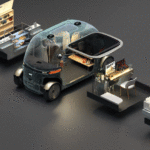Researchers have figured out a way of fusing polymers using “sonochemical reactions”.
Unless you’re a researcher in that field, or adjacent fields, it’s likely you’ve never heard of it before.
Much like a photochemical reaction, which has its curing initiated by photonic energy, a sonochemical reaction is initiated by soundwaves, specifically ultrasound waves.
The researchers from Concordia University, Canada, call this process DSP, or Direct Sound Printing, and this is how it works.
DSP
In the DSP process, the researchers use a transducer to fire an ultrasonic pulse into a fluid medium, in this case, it is a polydimethylsiloxane (PDMS) resin, which is a heat-cured thermoset plastic that has until now been impossible to print with traditional additive manufacturing methods.

The pulse hits the resin and causes the formation of bubbles, which oscillate at ultra high frequencies, causing the formation of heat within the bubble.
According to the research paper, released in Nature Communications, the sonochemical reactions are capable of producing extraordinary high temperature (exceeding 15,000 K), high pressures (exceeding 1000 bar) and fast heating and cooling rates (over 1012 K/s) inside the active cavitation bubbles, known as hotspots.
The extremes in heat and pressure last for just a tiny fraction of a second before the hot bubble causes the resin to cure in its exact location.
By moving the transducer along a toolpath, bubbles can be formed along that toolpath, thereby curing the resin as it moves.
At the focal location in the build material, the chemically active acoustic cavitation region solidifies the liquid resin and deposits it to the platform, or on top of previously deposited and solidified regions. The researchers call this region the ultra-active micro reactor (UAMR) zone, where generated bubbles and polymerized resin appear at the low-pressure zones and then they migrate momentarily to high-pressure zones until they reach the platform or previous solidified pixel where they are deposited. Think of the UAMR like a melt pool, for lack of a better analogy.
The DSP process is capable of producing complex geometries with zero to varying porosity and 280 μm feature size. are printed by our method, Direct Sound Printing (DSP), in a heat curing thermoset, Poly(dimethylsiloxane) that cannot be printed directly so far by any method.
The problem with printing heat-curable thermoset plastics like this is that not only a rapid heating time is required, but a rapid cooling time too. DSP offers both of these perks by nature of the rapidly forming temperature and the rapid cooling experienced in the bubble formation.

One notable feature of DSP is that the curing depth is not dependent on the optical opacity of the materials, unlike with SLA printing. This means that DSP can be used even for printing within the human body, by injecting a region with the material and curing it externally.
This has wide applications for bioprinting, and indeed the researchers have been experimenting with biological material printing also, having successfully printed with tissue phantoms and porcine cells. You can see the pork cell ear in the image below.

If you’d like to read more about the research, you can access the full paper over at this link.









